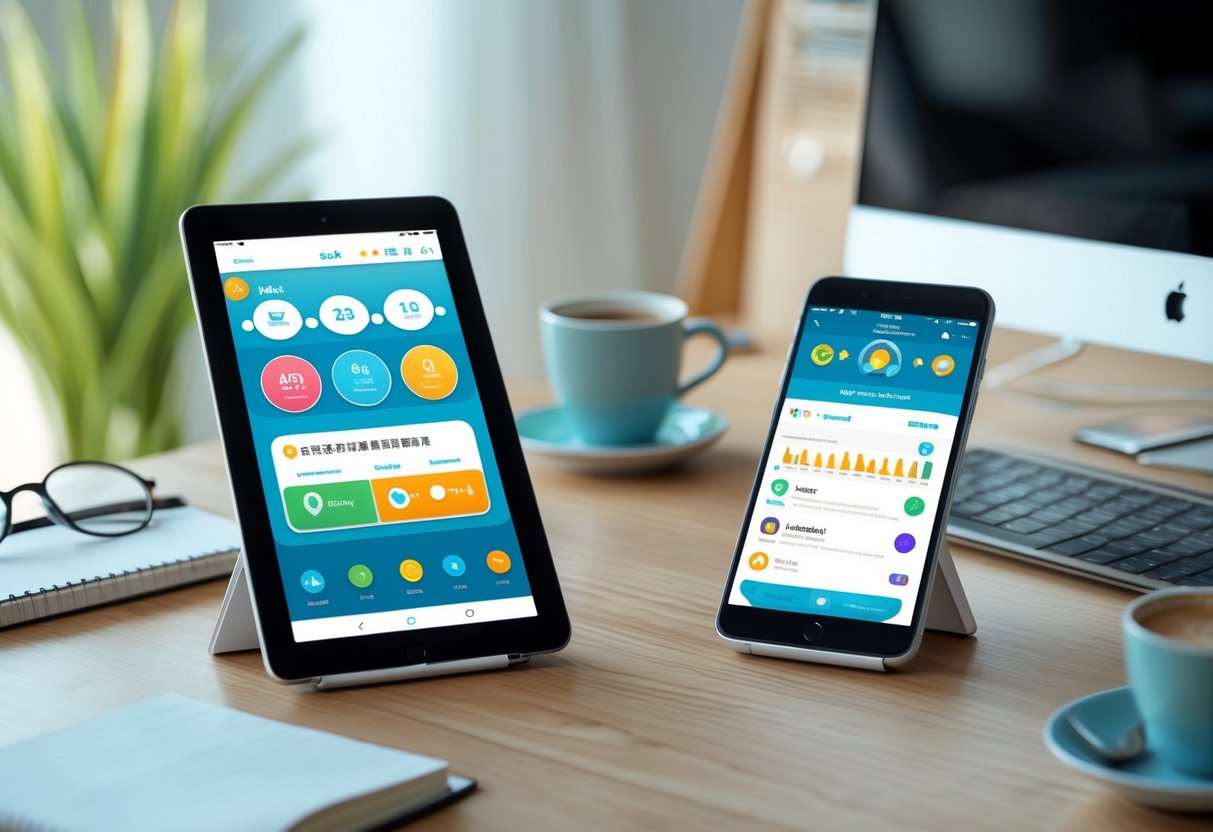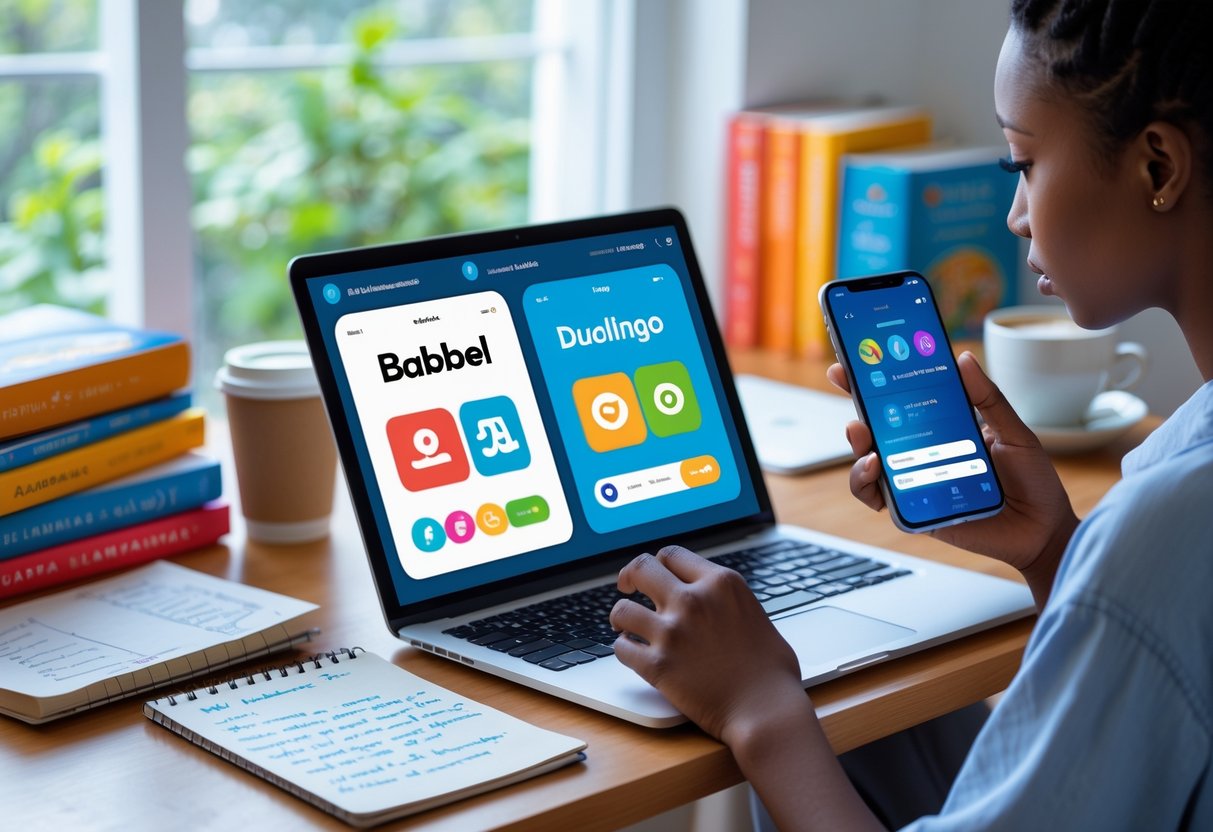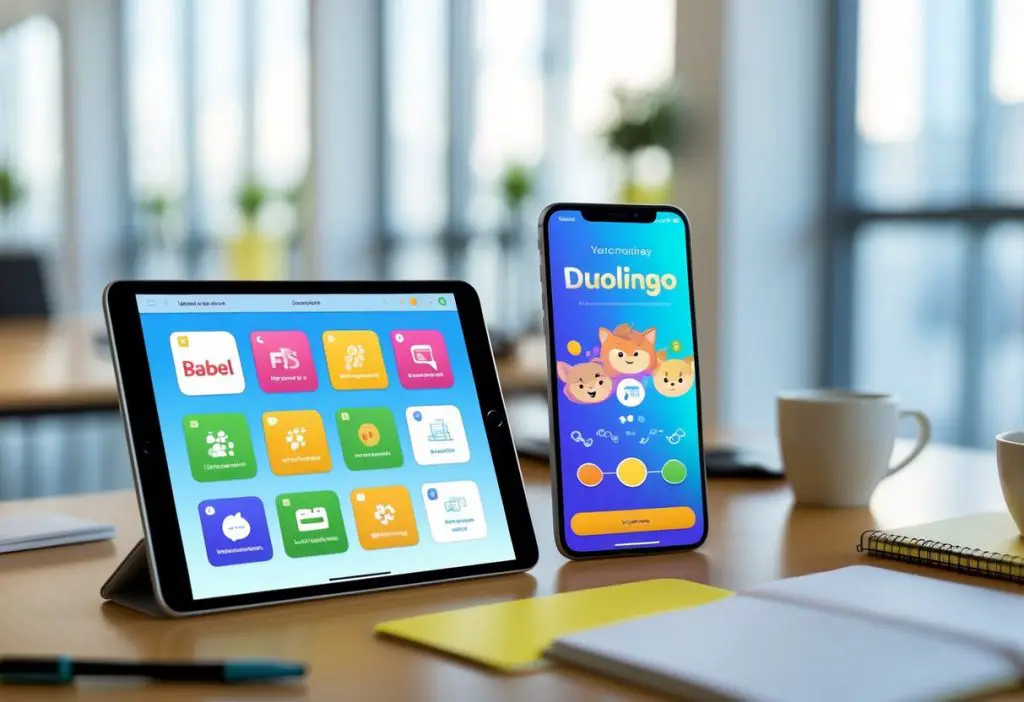Choosing between Babbel vs Duolingo can be tricky when you want to learn a new language. Babbel is better if you want clear grammar lessons and structured courses, while Duolingo works well for those who prefer games and quick, daily practice.
Both apps help millions of users, but your best choice depends on how you like to study and what keeps you motivated.
Key Takeaways
- Babbel and Duolingo have different teaching styles.
- You should pick an app based on your learning goals.
- Both apps can help you build language skills.
Babbel vs Duolingo: Key Differences

Babbel and Duolingo are popular online language learning apps, but they offer different ways to study foreign languages. These differences can affect how quickly you learn, how many languages you can choose, and how much you pay for each app.
Learning Approach and Structure
Babbel uses a lesson-based method. Each lesson has a clear focus on grammar, vocabulary, and practice. You follow a step-by-step path and every lesson builds on the last.
Lessons are designed by language learning experts. Babbel gives you helpful grammar tips and culture notes. You also get to practice speaking, listening, and writing.
Duolingo uses a game-like structure with short drills called “skills.” You earn points when you get answers right. The app uses repetition and encourages daily practice by sending reminders.
Duolingo focuses less on grammar rules and more on learning through practice with short phrases and sentences. It’s easy to jump around and try different topics, and you can use it for just a few minutes a day.
Supported Languages and Language Focus
Duolingo offers more than 40 languages, including popular ones like Spanish, French, and German, as well as less common ones like Hawaiian and Swahili.
Babbel focuses on about 14 languages, mostly European ones such as Spanish, French, Italian, and German. You won’t find languages like Japanese, Korean, or Arabic on Babbel.
If you want to learn a less common language, Duolingo has more choices. If you want a deeper study of European languages, Babbel has more in-depth lessons.
A quick look:
| App | Number of Languages | Highlights |
|---|---|---|
| Duolingo | 40+ | Wide selection, unique picks |
| Babbel | 14 | Strong focus on Europe |
Pricing and Access Options
Duolingo can be used for free. You can finish lessons and learn without paying. There is a paid plan called Duolingo Super. It removes ads and gives you extra features, like unlimited hearts (mistakes).
Babbel is mostly a paid service. You usually need a subscription to access all content, though there is sometimes a free lesson or trial to start.
Babbel subscriptions: Paid monthly, quarterly, yearly, or for a lifetime. Costs depend on the plan you choose.
Duolingo: Free forever, but the Super plan adds more features and removes ads. This table breaks it down:
| App | Free Access | Paid Option |
|---|---|---|
| Duolingo | Yes | Super: Ad-free, extras |
| Babbel | Limited | Full course access |
Babbel Features and User Experience

Babbel helps you learn new languages through structured courses, grammar lessons, and live instruction. You can pick from 14 languages and use different activities to improve your speaking, reading, and listening skills.
Course Design and Progression
Babbel courses start with simple words and phrases, then move step by step to more complex ideas. Courses are made by language experts. They follow a clear order, so you don’t miss important basics as you move on.
You can track your progress through each lesson. Each course is split into levels, so you always know where you stand. Babbel also lets you review past lessons to help reinforce what you’ve learned. The lessons usually last about 10-15 minutes, so they fit easily into your daily routine.
Key facts:
- 14 languages to choose from
- Courses divided by topic and skill level
- Short and focused lessons
Grammar Lessons and Cultural Context
Every Babbel language course includes grammar practice to help you understand how the language works. Lessons focus on sentence structure, verb forms, and word endings. You get clear examples to show you how to use grammar in real conversations.
Babbel also includes information about the culture where the language is spoken. You learn about customs, holidays, and real-life situations. This helps you use the language in context, not just memorize words.
What you’ll find:
- Direct grammar instruction
- Example sentences for real-life use
- Cultural notes to give you practical knowledge
Interactive Exercises and Babbel Live
You can practice reading, writing, listening, and speaking through interactive exercises. These include fill-in-the-blank tasks, matching games, and pronunciation checks using voice recognition.
For extra practice, Babbel Live offers hour-long group classes with certified teachers. These classes let you speak with other learners and get feedback in real time. You can ask questions and practice conversations in a supportive setting.
Highlights:
- Practice for all key language skills
- Voice recognition to help with pronunciation
- Live classes for extra speaking practice
Duolingo Features and User Experience
Duolingo uses interactive exercises and smart game features to help you practice a new language. Subscriptions like Super Duolingo offer extra tools, while the app is designed to be accessible and supportive for all language learners.
Gamification and Motivation
Duolingo uses game-like methods to keep you motivated. You earn XP points, win crowns, and unlock levels as you finish lessons. Bright colors and fun sounds make using the app feel like a game, not a chore.
You can also join daily and weekly leaderboards to compete with other learners. Earning streaks for studying each day gives you a small reward and makes you want to keep going. Badges and achievements highlight your progress and let you see how far you’ve come.
The lessons use short tasks and instant feedback, so you know right away if you got something right or wrong. Hints and tips pop up to help you, making learning feel less stressful.
Super Duolingo and Duolingo Plus
Duolingo offers paid subscriptions called Super Duolingo (formerly Duolingo Plus). With this service, you get an ad-free experience, so lessons go faster and are less distracting.
Super Duolingo also gives you unlimited hearts. This means you can make mistakes and keep learning, instead of waiting to try again. You get monthly progress reports and quizzes to track your improvement.
You can try Super Duolingo with a free trial before paying. If you choose not to upgrade, the regular free version still offers most key features. A quick comparison is below:
| Feature | Free Version | Super Duolingo |
|---|---|---|
| Ads | Yes | No |
| Unlimited Hearts | No | Yes |
| Progress Tracker | Basic | Detailed |
| Monthly Quizzes | No | Yes |
Accessibility and Community
Duolingo is available on both smartphones and computers. The app works for over 30 languages, including Spanish, French, German, and Japanese.
Simple, clean screens and easy navigation help you learn without feeling lost. Duolingo offers text-to-speech, adjustable font sizes, and color contrast options for better accessibility.
A strong online community is part of the experience. You can discuss language topics in Duolingo forums, ask questions, or share study tips with other learners. Many users join clubs or group challenges to keep motivated.
You can use Duolingo for free. Most features are very easy to use, even if you have never tried language learning apps before.
Choosing the Best Language Learning App for Your Goals

Each language learning app serves different needs, learning habits, and comfort levels with technology. Choosing Babbel or Duolingo will depend on how you learn best and what you want out of the experience.
Learning Styles and User Preferences
Language-learning apps use different approaches. Babbel is structured, gives clear lessons, and has a set path that builds language skills step-by-step. This works well if you like a classroom feel and want to see your progress.
Duolingo uses short lessons with lots of repetition and a playful style. The focus is more on keeping you motivated with streaks, rewards, and short daily goals. If you learn best through games or want to study at your own pace, this style will suit you.
Online language learning can also depend on your favorite device. Babbel works best on computers and tablets, while Duolingo is easy to use on smartphones. If you want to fit practice into small moments, a mobile-friendly platform like Duolingo can be useful.
Who Should Use Babbel
You should pick Babbel if you want clear lessons that teach grammar, vocabulary, and conversations in a logical order. Babbel is a good choice if you need more structure than other language-learning apps offer.
Babbel’s language learning platform is useful if you mainly want to read, write, and speak in real-life situations. The app’s bite-sized lessons take about 10–15 minutes, making it possible to fit into a busy schedule.
If you prefer a traditional learning method with explanations and examples, Babbel is the better option. People who are serious about using a language at work or while traveling may find Babbel extremely helpful.
Who Should Use Duolingo
Duolingo is useful if you want a free language learning app with game features. If a sense of fun and achievement helps you stick with online language learning, Duolingo will be a good fit.
Duolingo offers hundreds of short activities for reading, listening, writing, and speaking. Learners who get bored easily or who like to see quick points and rewards will enjoy using this platform.
If you want to explore many languages or learn at your own pace without a big commitment, Duolingo makes it easy. Duolingo is good for beginners or those who want to learn a little every day without feeling pressured.
Frequently Asked Questions

Babbel and Duolingo have different ways of teaching new languages and use different lesson types. Their pricing, language programs, user feedback, and lesson designs all vary in notable ways.
What are the main differences in teaching methodologies between Babbel and Duolingo?
Babbel uses a structured curriculum with lessons built by language experts. The lessons focus on grammar, vocabulary, and conversation for practical use. Duolingo uses short, game-like exercises. You move through lessons by earning points and leveling up. The learning is more focused on repetition and translation tasks.
How do subscription costs compare between Babbel and Duolingo?
Babbel is a paid service after its first lesson, with monthly, quarterly, and annual plans. Prices usually start around $14 per month, with savings for longer plans. Duolingo offers a free version with ads. Its paid version, Duolingo Super, removes ads and costs about $7 to $13 per month, depending on the plan you choose.
Which platform, Babbel or Duolingo, offers a more comprehensive Spanish learning program?
Babbel’s Spanish program includes grammar explanations, practice in real conversations, and cultural tips. The courses are arranged by topic and skill level. Duolingo covers vocabulary and basic grammar. The app uses repetition to help you remember new words, but grammar explanations are shorter and less detailed than Babbel’s.
Between Babbel and Duolingo, which language learning app is more effective for French?
Babbel’s French course includes more structured grammar exercises and conversation practice. This can help you learn how to use French in real life. Duolingo teaches French with shorter, quicker lessons. The app helps build vocabulary and review simple sentences.
How do Babbel and Duolingo compare in terms of their lesson structure and content progression?
Babbel’s lessons follow a set path built around real-life situations. Each lesson adds to your previous knowledge in a step-by-step way. Duolingo uses a tree or path that lets you repeat lessons as much as you want. You earn points as you progress and unlock new units by completing earlier ones.

